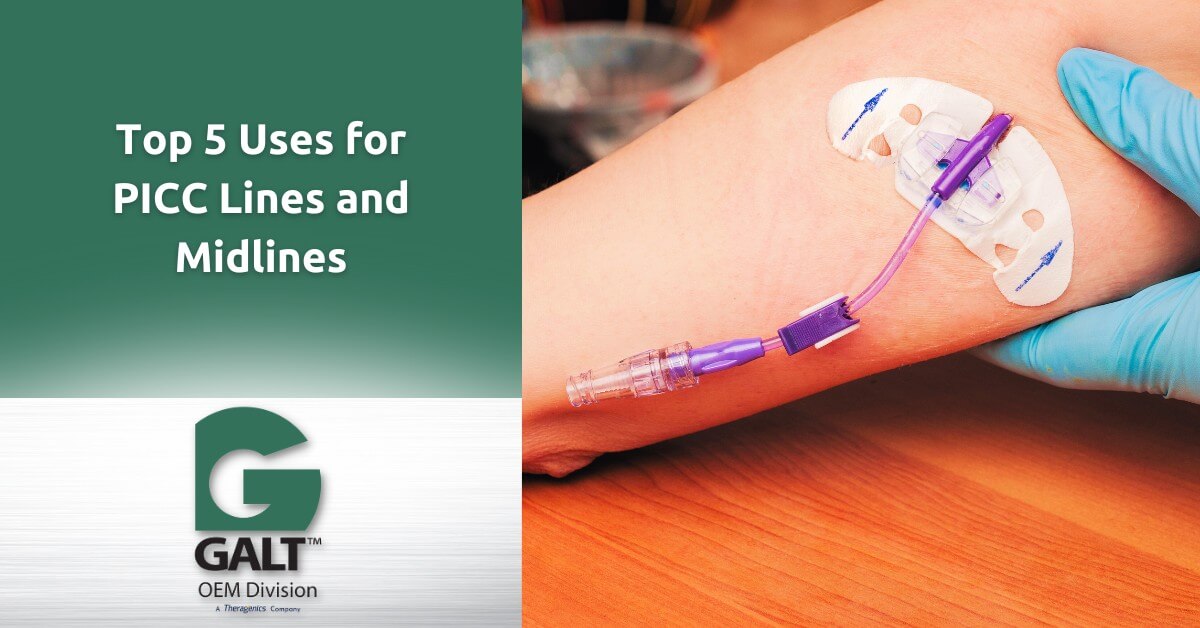Top 5 Uses for PICC Lines and Midlines

PICC (peripherally inserted central catheters) lines and midlines are both highly effective and versatile vascular access devices. Both are used for treatments that require medications to be given repeatedly over a period of time. One of the main benefits is you only have to achieve vascular access once for multiple treatments rather than obtaining a new access through multiple IVs (needle sticks) each time you administer the therapy.
The choice between a PICC line and midline device depends on a range of factors, including:
- Patient’s medical condition
- Type of treatment required
- Duration of the treatment
- Potential for irritation or damage to the veins by the therapies being infused
PICC lines are generally used for therapies that are:
- More irritating to veins
- Administered over a longer period of time
Midlines are generally used for therapies that are:
- Less irritating to veins
- Administered over shorter time periods
An Overview of PICC Lines
PICC lines are long catheters usually inserted through a peripheral vein in the arm. The catheter is then threaded through the vein until the tip reaches the largest vein in the human body, the superior vena cava, located above the heart.
PICC lines can remain in place for weeks and even months if necessary.
They can also have multiple lumens, allowing the simultaneous administration of different therapies.
An Overview of Midlines
Midlines are typically used for short- to medium-term intravenous therapy. Like a PICC line, a midline catheter is inserted through a peripheral vein in the arm. However, midlines are around half the length of a PICC line. As a result, the tip is typically positioned distal to the shoulder in the subclavian or axillary vein.
Midlines are typically used when the planned treatment will last between one and four weeks.
Top Five Uses for PICC Lines
1. Administration of Medication
PICC lines are used to administer therapies for a range of conditions. This can include:
- Chemotherapy drugs for the treatment of cancer as well as other targeted cancer therapy drugs.
- Antibiotic therapies to treat serious infections, particularly where oral medications are not effective.
- Antifungal or antiviral medications to treat severe fungal or viral infections.
- Other medications that can irritate smaller veins. Therapies administered through a PICC line go directly to the larger veins of the chest. As these veins carry more blood, the medicines are diluted faster, lowering the risk of vein irritation.
2. Total Parenteral Nutrition (TPN)
PICC lines are used for the delivery of nutrition directly into the bloodstream for patients who are unable to eat or have digestive problems and can’t process food for nutrients.
3. Fluid Replacement
PICC lines are used to provide fluids, electrolytes, and other nutritional supplements to patients who are unable to take them orally.
4. Blood Sampling
PICC lines prevent the need for repeated needle sticks when regular blood samples have to be taken from a patient.
5. Blood Product Administration
PICC lines are used for blood transfusions and the transfusion of other blood products.
Top 5 Uses for Midlines
The top five uses for midlines are very similar to the main uses of PICC lines. The duration of the treatment and the nature of the therapy are the main differentiating factors.
1. Administration of Medications
Midlines are used to administer antibiotics and other medications that are not irritating to veins. In other words, midlines are generally not used for chemotherapy and other vein-irritating drugs.
2. Parenteral Nutrition
As with PICC lines, midlines can be used to provide parenteral nutrition to patients who cannot ingest food. The difference is that PICC lines are used when patients require long-term nutrition (TPN), while midlines are for patients with shorter-term parenteral nutrition needs.
3. Fluid Replacement
Similar to PICC lines, midlines are used to provide fluids and electrolytes to patients who need IV hydration. Again, midlines are preferred in situations where the planned treatment timescales are shorter, while PICC lines are used when fluid replacement will be needed for a longer period of time.
4. Blood Sampling
Midlines can be used for blood sampling in a similar way to PICC lines. Midlines are often the preferred option when blood draws are required less frequently.
5. Administration of Other Treatments
Midlines are also used to administer medical treatments that do not require central venous access.
Summary
PICC lines and midlines have many similarities as well as key differences. When selecting the best option, both have advantages depending on the patient and the therapy being administered. For the patient, the benefits compared to alternative treatment methods include a reduced risk of infection and fewer needle sticks, making both PICC lines and midlines transformational in terms of positive patient outcomes.
.
.
